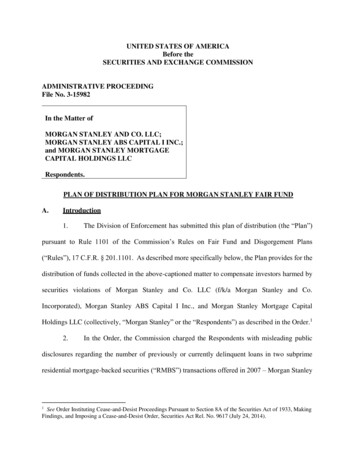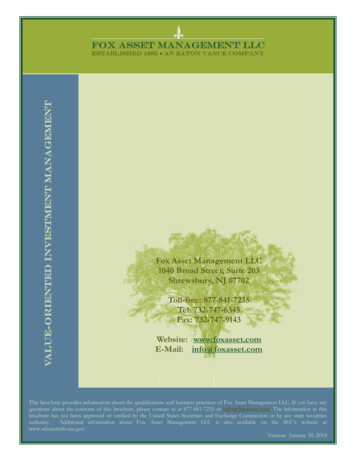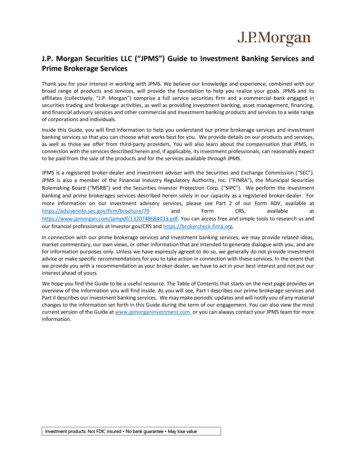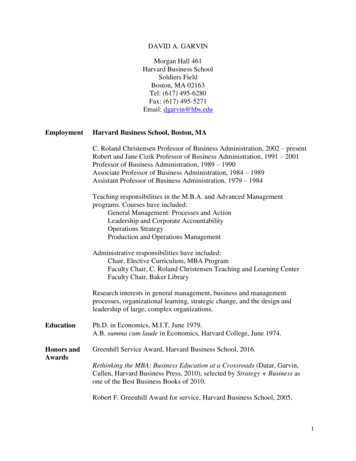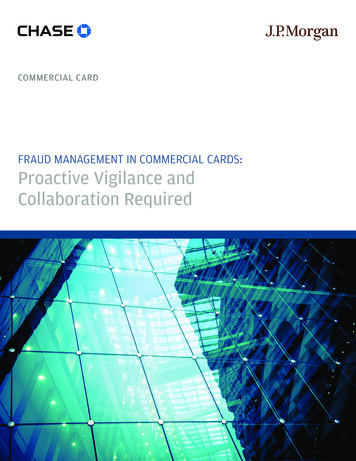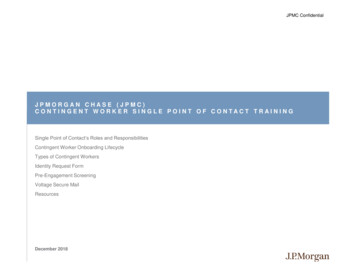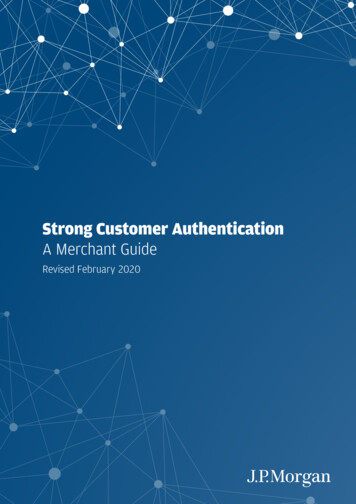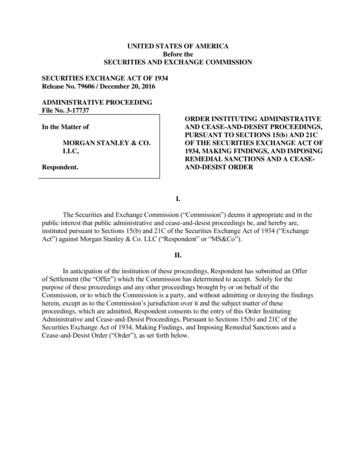
Transcription
UNITED STATES OF AMERICABefore theSECURITIES AND EXCHANGE COMMISSIONSECURITIES EXCHANGE ACT OF 1934Release No. 79606 / December 20, 2016ADMINISTRATIVE PROCEEDINGFile No. 3-17737ORDER INSTITUTING ADMINISTRATIVEAND CEASE-AND-DESIST PROCEEDINGS,PURSUANT TO SECTIONS 15(b) AND 21COF THE SECURITIES EXCHANGE ACT OF1934, MAKING FINDINGS, AND IMPOSINGREMEDIAL SANCTIONS AND A CEASEAND-DESIST ORDERIn the Matter ofMORGAN STANLEY & CO.LLC,Respondent.I.The Securities and Exchange Commission (“Commission”) deems it appropriate and in thepublic interest that public administrative and cease-and-desist proceedings be, and hereby are,instituted pursuant to Sections 15(b) and 21C of the Securities Exchange Act of 1934 (“ExchangeAct”) against Morgan Stanley & Co. LLC (“Respondent” or “MS&Co”).II.In anticipation of the institution of these proceedings, Respondent has submitted an Offerof Settlement (the “Offer”) which the Commission has determined to accept. Solely for thepurpose of these proceedings and any other proceedings brought by or on behalf of theCommission, or to which the Commission is a party, and without admitting or denying the findingsherein, except as to the Commission’s jurisdiction over it and the subject matter of theseproceedings, which are admitted, Respondent consents to the entry of this Order InstitutingAdministrative and Cease-and-Desist Proceedings, Pursuant to Sections 15(b) and 21C of theSecurities Exchange Act of 1934, Making Findings, and Imposing Remedial Sanctions and aCease-and-Desist Order (“Order”), as set forth below.
III.On the basis of this Order and Respondent’s Offer, the Commission finds1 thatSummary1.Exchange Act Rule 15c3-3 (“Rule 15c3-3”), 17 CFR 240.15c3-3, also known as theCustomer Protection Rule, establishes a regulatory framework that requires broker-dealers to takecertain steps to safeguard the funds and securities entrusted to them by their customers. Forcustomer cash, Rule 15c3-3 requires that broker-dealers deposit the net amount owed to customersinto a separate customer reserve account (“Reserve Account”). The purpose of this requirement isto prevent customer cash from being used to finance a broker-dealer’s business or trading activitiesunrelated to servicing its securities customers and to segregate the cash so that it can be promptlyreturned to customers in the event of the broker-dealer’s failure. The Customer Protection Rulealso prevents broker-dealers from using transactions with affiliated entities to reduce the amountthat they are required to deposit into their Reserve Accounts.2.As customers of the financial services firm Morgan Stanley (“MS”) sought to enterequity swaps with the firm’s prime brokerage platform to obtain synthetic exposure to less liquid,emerging markets equity securities, MS’s global prime brokerage business (“Prime Broker”), inturn, would purchase the underlying equities to hedge its market exposure. Beginning in 2012, thePrime Broker sought a means to finance these hedges in the manner in which it finances customercash positions, thereby reducing costs—and correspondingly increasing profits—in connectionwith the establishment of these hedges. The solution was to create an affiliate, Morgan StanleyEquity Financing Limited (“MSEFL”), to sign MSEFL up as a prime brokerage customer ofMS&Co, a U.S. broker-dealer subsidiary of MS, and to provide MSEFL financing via margin loansfrom MS&Co. Ultimately, the funds from these margin loans were used to finance the hedges.3.From March 2013 to May 2015, the Prime Broker used MSEFL to financesecurities acquired as hedges to equity swaps with its customers, which had the effect of reducingthe amount MS&Co was required to deposit into its Reserve Account.4.MS&Co personnel failed to appreciate that this use of an affiliate and this use ofcustomer cash to finance the purchase of hedges violated the Customer Protection Rule. While thesecurities financed through MSEFL were acquired as hedges to customers’ equity swaps, thesecurities were firm positions that were purchased to hedge the firm’s market exposure. TheCustomer Protection Rule and guidance issued by the SEC staff state that transactions withaffiliates of a broker-dealer may not serve to reduce the amount that the broker-dealer is required todeposit in its Reserve Account.5.MS&Co inaccurately calculated its Reserve Account requirement under Rule 15c33 by including the margin loans to MSEFL in its calculations. These incorrect calculations also1The findings herein are made pursuant to Respondent’s Offer of Settlement and are notbinding on any other person or entity in this or any other proceeding.2
resulted in it making inaccurate records and submitting inaccurate reports to theCommission. Accordingly, MS&Co willfully violated Sections 15(c)(3) and 17(a)(1) of theExchange Act and Rules 15c3-3(e), 17a-5(a), and 17a-5(d) thereunder.6.In response to the Commission’s investigation, MS&Co provided substantialcooperation to Commission staff. MS&Co also has voluntarily undertaken steps to review theprocesses responsible for the calculation requirements of Rule 15c3-3 and is taking remedial stepsto improve those processes.Respondent7.Morgan Stanley & Co. LLC is a Delaware limited liability company with itsprincipal place of business in New York, NY. It is a wholly owned subsidiary of MS. MS&Co hasbeen registered with the Commission as a broker-dealer pursuant to Section 15(b) of the ExchangeAct since 1970 and is a Financial Industry Regulatory Authority member.Other Relevant Entity8.Morgan Stanley Equity Financing Limited is a United Kingdom private limitedcompany incorporated on July 6, 2012. It is a subsidiary of Morgan Stanley Longcross Limited,which is a subsidiary of Morgan Stanley & Co. International plc (“MSIP”), a United Kingdombroker-dealer and wholly owned subsidiary of Morgan Stanley. During the relevant time period,MSEFL was an affiliate and a prime brokerage customer of MS&Co.BackgroundA.The Issue: Financing Firm Hedges of Customer Swaps9.Within MS, there are several subsidiary broker-dealers. Among them are MS&Co,which is a U.S. broker-dealer subsidiary of MS, and MSIP, which is a U.K. broker-dealersubsidiary. Across these broker-dealers, MS offers its customers a prime brokerage platform,including access to Delta One Structured Products (“DSP”) desks that offer customers syntheticexposure to specific securities through derivatives. For example, to meet customer demand forsynthetic exposure to equity securities—i.e., exposure to price changes in an equity securitywithout owning that equity security itself—a DSP desk will enter into an equity swap with acustomer.210.A customer entering into an equity swap with a DSP desk can take a long or shortposition vis-à-vis the underlying equity. If the customer goes long, then it is exposed to the sameperformance as if it owned the equity. Conversely, if the customer short sells the underlying equitythrough an equity swap, it obtains short exposure to that equity.2The equity swaps at issue are agreements whereby two parties agree to the periodicexchange of future cash flows over a specified period of time, with one party makingpayments based on a fixed or floating (e.g., LIBOR) rate and with one or the other partymaking payments based on the performance of a designated equity.3
11.When entering into an equity swap with a customer, the DSP desk seeks to remainas neutral as possible in terms of its own market exposure. To hedge its exposure to the equityswap customer, the DSP desk generally would purchase the underlying equity for an equity swapwhere the customer had long exposure and would short sell the underlying equity where thecustomer had short exposure (“DSP Hedge”).312.MS imposed a cost on trading desks for using firm capital to purchase theirpositions, including DSP Hedges. MS makes capital available to its trading desks but charges aninterest rate on this capital, known as a proxy rate, that typically is higher than the interest thatexternal third parties charge for collateralized loans. To avoid being assessed this more expensiveinternal financing rate, MS can finance its positions externally through a securities lendingagreement. For example, MS&Co often rehypothecates customer margin securities in order togenerate financing for customer margin loans.413.In connection with the Prime Broker’s international synthetics business inparticular, a portion of the DSP Hedges were less liquid, emerging markets equities (“EM DSPHedges”), and as a result, they were more difficult to finance externally.14.Although a broker-dealer may rehypothecate liquid securities and use the fundsobtained to finance less liquid positions, the equity swaps traded in connection with theinternational synthetics business were largely booked in MSIP which held only a limited amount ofliquid securities. Because the EM DSP Hedges exceeded MSIP’s liquid securities available forrehypothecation, the DSP desks were required to pay MS’s proxy rate to finance the EM DSPHedges.15.MS&Co held a substantial amount of liquid customer margin securities that wereeligible for rehypothecation under Rule 15c3-3. Recognizing that MS&Co had a surplus of liquidcustomer margin securities and MSIP had a deficit for rehypothecation purposes, Prime Brokerpersonnel began to explore whether DSP desks could access external financing that MS&Co couldgenerate through rehypothecation in order to more cheaply finance the EM DSP Hedges.3Short selling is the practice of selling securities that are not currently owned andsubsequently purchasing them, which is known as “covering” the short position. In theevent of an interim price decline prior to covering, the short seller will profit, since thecost of purchase will be less than the proceeds which were received upon the initial shortsale. Conversely, the short position will result in a loss if the price of the shorted securityrises prior to covering. The broker-dealer clearing the short sale must borrow thesecurities in order to effect delivery upon execution of the short sale.4Rehypothecation is the practice of using the assets held as collateral for a client to financethe client’s positions. This allows a broker-dealer to re-lend customer margin securitiesheld as collateral. If a customer purchases securities through a margin loan extended by aU.S. broker-dealer, the securities purchased are treated as collateral for the margin loanand are eligible for rehypothecation, within limits set forth in Rule 15c3-3. Fully paidand excess margin securities may not be rehypothecated under Rule 15c3-3.4
16.Within certain limits, the Customer Protection Rule allows a broker-dealer to financeone customer’s margin activity with another customer’s assets, but does not allow one brokerdealer’s customer activity to finance another broker-dealer’s activities. As described below, thePrime Broker conceived of an affiliate that would transact with MS&Co, on one hand, and the DSPdesks, on the other hand, for the purpose of providing financing for the EM DSP Hedges that wasbelow the proxy rate.B.The Proposed Solution: Affiliated Entity MSEFL17.In early 2012, senior personnel from the Prime Broker developed a transactionstructure centered on the use of an affiliate of MS&Co to hold the EM DSP Hedges, which itwould purchase with funds obtained from margin loans extended by MS&Co. Following someinitial meetings with relevant stakeholders regarding the broad contours of this idea, a NewProduct Approval (“NPA”) process was initiated in April 2012.518.The affiliate—which eventually became MSEFL—would be a prime brokeragecustomer of MS&Co. Through this relationship, MSEFL would receive margin loans fromMS&Co. MS&Co would fund these margin loans through the rehypothecation of its othercustomers’ liquid margin securities.19.The EM DSP Hedges would trade in an MS account for global DSP desks, butwould settle in MSEFL’s prime brokerage account. Therefore, the funds from the margin loansfrom MS&Co would be used to purchase or to borrow the EM DSP Hedges. In addition, the DSPdesks would transfer the economics of the relevant, underlying equity swaps to MSEFL via a totalreturn swap. The mechanics of the proposed transaction structure were as follows:5NPA is an MS process instituted upon the proposal of new, reintroduced, or modifiedproducts, services, or businesses in order to allow control functions to formally reviewsuch proposals.5
20.The Prime Broker estimated that, by avoiding MS’s proxy rate, MSEFL couldachieve cost savings of up to 34 million per year. The Prime Broker’s use of MSEFL wasultimately more limited, and the Prime Broker thus did not realize this amount of savings.21.From April to August 2012, the NPA was reviewed by stakeholders, including theLegal and Compliance Division and the Financial Control Group, which is responsible for ensuringMS&Co maintains sufficient funds to safeguard customer cash under Rule 15c3-3.C.The Problem with the Proposed Solution: The Customer Protection Rule22.Rule 15c3-3 imposes restrictions and responsibilities on a broker-dealer that aredesigned to safeguard its customers’ cash and securities so that these assets can be promptlyreturned if the broker-dealer fails. As to customer cash, Rule 15c3-3 requires a broker-dealer tomaintain a reserve of funds and/or certain qualified securities in its Reserve Account that is at leastequal in value to the net cash owed to customers. 17 CFR 240.15c3-3(e). The amount required tobe maintained in the Reserve Account is based upon a computation typically performed on aweekly basis, which is calculated pursuant to a formula contained in Exhibit A to Rule 15c3-3(“Reserve Formula”).6 See id. 240.15c3-3a. Subject to some adjustments, Rule 15c3-3 requiresthat a broker-dealer hold an amount equal to at least the excess of “credits” over “debits” in itsReserve Account. Id. 240.15c3-3(e). The term “credits” refers to the amount of cash the brokerdealer owes its customers or cash derived from the use of customer securities, while “debits” refersto amounts the customers owe the broker-dealer, for example due to margin loans extended tocustomers. See id. 240.15c3-3a.6During the relevant period, MS&Co performed this computation on a daily basis.6
23.The proposed transaction structure involving MSEFL was problematic for tworeasons. First, the stated intent and objective of Rule 15c3-3 is to “eliminat[e] . . . the use bybroker-dealers of customer funds and securities to finance firm overhead and such firm activities astrading and underwriting through the separation of customer related activities from other brokerdealer operations.” Exch. Act Rel. No. 9775, 1972 WL 125434, at *1 (Sept. 14, 1972).7 The EMDSP Hedges were used to hedge the Prime Broker’s risk arising out of equity swaps with the PrimeBroker’s customers, which was transferred to MSEFL, an affiliate of MS&Co. As a result, thefinancing of the EM DSP Hedges was inconsistent with Rule 15c3-3.24.Second, as described below, the transaction structure allowed for the impermissiblereduction of the Reserve Account through the debits of an affiliate.25.The margin loans from MS&Co to MSEFL established a potential debit thatMS&Co intended to use to reduce its Reserve Account by the same amount as the margin loans.In mid-August 2012, however, Prime Broker personnel identified a problem with the inclusion ofthis debit in the Reserve Formula.26.Because broker-dealers could potentially seek to reduce their Reserve Accountrequirement through affiliates, Rule 15c3-3 also limits a broker-dealer’s ability to include debitsgenerated by the activity of affiliates. Note E(4) of the Reserve Formula (“Note E(4)”) providesthat the debits of affiliates should be excluded “unless the broker or dealer can demonstrate thatsuch debit balances are directly related to credit items in the formula.” In other words, debitsattributable to an affiliate’s positions can be included in a broker-dealer’s Reserve Formula only tothe extent that there are directly related credits attributable to those positions. This limitationimposed by Note E(4) is designed to ensure that debits related to affiliate activity, on a net basis,will not reduce a broker-dealer’s Reserve Account requirement.27.The debit resulting from the margin loans to MSEFL had no directly related creditand thus would have improperly reduced MS&Co’s Reserve Account. Initially, MS&Co believedthat the credits resulting from the rehypothecation of MS&Co’s other customers’ liquid marginsecurities could be considered directly related. But, as the Financial Control Group advised, “thecredit must arise from the rehypothecating of the affiliates [sic] own collateral to be deemeddirectly related.” As such, the Prime Broker concluded that it could not achieve the desired costsavings because of the absence of a directly related credit and considered further options todetermine whether it could operationalize MSEFL.7See also id. (one objective of the Rule was to “inhibit the unwarranted expansion of abroker-dealer’s business through the use of customers’ funds by prohibiting the use ofthose funds except for designated purposes”); Exch. Act Rel. No. 21651, 50 FR 2690-01at 2690 (Jan. 18, 1985) (Rule 15c3-3 “forbid[s] brokers and dealers from using customerassets to finance any part of their businesses unrelated to servicing securities customers;e.g., a firm is virtually precluded from using customer funds to buy securities for its ownaccount”).7
D.The Proposed Fix: Transferring Short Sale Proceeds to MSEFL28.In an effort to keep the debit that would be generated by MS&Co’s margin loan toMSEFL in the Reserve Formula, the Prime Broker explored whether they could identify directlyrelated credits to add to the transaction structure. In or about early September 2012, the PrimeBroker considered whether the problem might be resolved by having the DSP desk transferseparate short sale positions—the proceeds of which are credits in the Reserve Formula—toMSEFL.29.As mentioned above, the DSP desks could trade equity swaps that offeredcustomers either long or short synthetic exposure to underlying equities. When a DSP desk offeredshort exposure through an equity swap, the DSP desk would establish the DSP Hedge by shortingthe underlying equity and, in doing so, receive short sale proceeds.30.To implement this updated transaction structure, MSEFL would sell short to theDSP desk the underlying equities that the DSP desk had shorted to establish the DSP Hedge. TheDSP desk would use the proceeds from its own short sales to pay MSEFL for these equities.MS&Co would then borrow the underlying equities and deliver them to the DSP desk to coverMSEFL’s short sales, and MS&Co would credit MSEFL with short sale proceeds. The DSP desk,in turn, could then close out its short sales. The revised transaction structure included thefollowing additional elements:8
E.The Problem with the Proposed Fix: The Customer Protection Rule31.Prior to its approval and implementation, MS&Co did not realize that this updatedtransaction structure achieved a result contrary to Rule 15c3-3 generally and the purpose of NoteE(4).32.MS&Co intended for MSEFL’s short sale proceeds to serve as the directly relatedcredit for purposes of the debit resulting from the margin loans to MSEFL. Therefore, MS&Cobelieved that it could now offset that debit in its Reserve Formula.33.When MS&Co borrowed the underlying equities to execute the short sale, however,that borrow was included as a debit in its Reserve Formula. Therefore, MS&Co was claiming thata credit (the short sale proceeds) was directly related to MSEFL’s debit (the margin loan fromMS&Co) even though that same credit already generated a separate, offsetting debit (the stockborrow).34.MS&Co was improperly using the same credit to offset two different debits—specifically, relying on a credit that already offset another debit in order to serve as the directlyrelated credit for purposes of the s
equity swaps with the firm’s prime brokerage platform to obtain synthetic exposure to less liquid, emerging markets equity securities, MS’s global prime brokerage business (“Prime Broker”), in turn, would purchase the underlying equi
